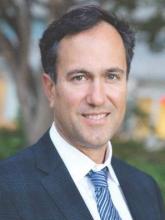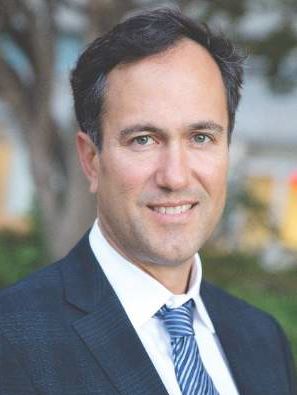User login
With treatments evolving rapidly for aortic diseases, best approaches and optimal use of technology will be the focus of “New Developments in Diseases of the Aorta and their Treatment,” on Saturday afternoon.
“As we keep pace with developments in stent graft technology, it is critical to also hone our understanding of aortic aneurysm pathology and make sure the technology fits the disease and not vice versa,” said co-moderator Dr. Thomas S. Maldonado, chief of vascular surgery at Manhattan VA Hospital, New York University Medical Center, New York. “The session features a number of interesting talks on aortic and iliac artery morphology as it relates to EVAR.”
The session will be co-moderated by Dr. Nicholas J.W. Cheshire, chief of vascular surgery for Aortic Centre, Royal Brompton Hospital in London.
Dr. Maldonado said attendees will learn about the role of preoperative neck thrombus and aortic sac morphology in planning endovascular repair as well as innovative solutions for complex iliac anatomy during EVAR. The session will also address the critical topic of EVAR for treatment of aortic aneurysm rupture and aortic trauma.
“Despite enthusiasm for endovascular management of ruptured AAA and aortic trauma, many centers lack cohesive protocols and strategies,” Dr. Maldonado said. “Experts will share their paradigms and tips and tricks for management of emergent EVAR for rupture and trauma.”
The session will be broken into two primary themes. The first half will address aortic aneurysm morphology and preoperative assessment of anatomy with the goal of achieving optimal endovascular repair, Dr. Maldonado said. The second half of the session will focus on emergent or urgent repair of aortic morphology, specifically aortic aneurysm rupture and blunt abdominal aortic trauma.
“This is an area that is hotly contested because traditionally, we’ve all been taught that ruptured aneurysm should be treated with open repair as expeditiously as possible,” he said. “The idea that perhaps endovascular repair – especially when there may be some need for preoperative imaging that might delay repair – is why there is some controversy as to whether endovasular repair has superiority over open repair. I think there is a lot of valuable insight in some of the talks in this session relating to” these issues.
At the start of the session, Dr. Maldonado will discuss quantitation of aortic neck and sac thrombosis and whether neck thrombosis is a risk factor for unsuccessful EVAR. Next, Dr. Benjamin M. Jackson of the Hospital of the University of Pennsylvania, Philadelphia, will address whether saccular AAAs should be treated differently from other AAAs and size criteria physicians should consider. Dr. Barend M.E. Mees of Maastricht University Medical Center, the Netherlands, will then conduct a presentation on back table reversed limb endografts (zenith and endurant) and technique/indications pertaining to treating challenging aorto-lliac pathology. Next up, Dr. Irwin V. Mohan of Westmead Hospital in Sydney, Australia, will discuss the lack of seasonality for ruptured AAAs. Presenters Dr. Zoran Rancic, Dr. Dieter O. Mayer, and Dr. Mario L. Lachat, all of the Clinic for Cardiovascular Surgery, University Hospital Zürich, Switzerland, will then host a dedicated workshop focused on improving treatment of ruptured AAAs. Finally, Dr. Zachary M. Arthurs of San Antonio Military Medical Center, San Antonio, Texas, will address blunt abdominal aortic injury, including incidence, etiology, diagnosis and treatment.
Session 108: New Developments in Diseases of the Aorta and their Treatment
Saturday, 3:05 p.m. – 3:35 p.m.
Grand Ballroom East, 3rd Floor
With treatments evolving rapidly for aortic diseases, best approaches and optimal use of technology will be the focus of “New Developments in Diseases of the Aorta and their Treatment,” on Saturday afternoon.
“As we keep pace with developments in stent graft technology, it is critical to also hone our understanding of aortic aneurysm pathology and make sure the technology fits the disease and not vice versa,” said co-moderator Dr. Thomas S. Maldonado, chief of vascular surgery at Manhattan VA Hospital, New York University Medical Center, New York. “The session features a number of interesting talks on aortic and iliac artery morphology as it relates to EVAR.”
The session will be co-moderated by Dr. Nicholas J.W. Cheshire, chief of vascular surgery for Aortic Centre, Royal Brompton Hospital in London.
Dr. Maldonado said attendees will learn about the role of preoperative neck thrombus and aortic sac morphology in planning endovascular repair as well as innovative solutions for complex iliac anatomy during EVAR. The session will also address the critical topic of EVAR for treatment of aortic aneurysm rupture and aortic trauma.
“Despite enthusiasm for endovascular management of ruptured AAA and aortic trauma, many centers lack cohesive protocols and strategies,” Dr. Maldonado said. “Experts will share their paradigms and tips and tricks for management of emergent EVAR for rupture and trauma.”
The session will be broken into two primary themes. The first half will address aortic aneurysm morphology and preoperative assessment of anatomy with the goal of achieving optimal endovascular repair, Dr. Maldonado said. The second half of the session will focus on emergent or urgent repair of aortic morphology, specifically aortic aneurysm rupture and blunt abdominal aortic trauma.
“This is an area that is hotly contested because traditionally, we’ve all been taught that ruptured aneurysm should be treated with open repair as expeditiously as possible,” he said. “The idea that perhaps endovascular repair – especially when there may be some need for preoperative imaging that might delay repair – is why there is some controversy as to whether endovasular repair has superiority over open repair. I think there is a lot of valuable insight in some of the talks in this session relating to” these issues.
At the start of the session, Dr. Maldonado will discuss quantitation of aortic neck and sac thrombosis and whether neck thrombosis is a risk factor for unsuccessful EVAR. Next, Dr. Benjamin M. Jackson of the Hospital of the University of Pennsylvania, Philadelphia, will address whether saccular AAAs should be treated differently from other AAAs and size criteria physicians should consider. Dr. Barend M.E. Mees of Maastricht University Medical Center, the Netherlands, will then conduct a presentation on back table reversed limb endografts (zenith and endurant) and technique/indications pertaining to treating challenging aorto-lliac pathology. Next up, Dr. Irwin V. Mohan of Westmead Hospital in Sydney, Australia, will discuss the lack of seasonality for ruptured AAAs. Presenters Dr. Zoran Rancic, Dr. Dieter O. Mayer, and Dr. Mario L. Lachat, all of the Clinic for Cardiovascular Surgery, University Hospital Zürich, Switzerland, will then host a dedicated workshop focused on improving treatment of ruptured AAAs. Finally, Dr. Zachary M. Arthurs of San Antonio Military Medical Center, San Antonio, Texas, will address blunt abdominal aortic injury, including incidence, etiology, diagnosis and treatment.
Session 108: New Developments in Diseases of the Aorta and their Treatment
Saturday, 3:05 p.m. – 3:35 p.m.
Grand Ballroom East, 3rd Floor
With treatments evolving rapidly for aortic diseases, best approaches and optimal use of technology will be the focus of “New Developments in Diseases of the Aorta and their Treatment,” on Saturday afternoon.
“As we keep pace with developments in stent graft technology, it is critical to also hone our understanding of aortic aneurysm pathology and make sure the technology fits the disease and not vice versa,” said co-moderator Dr. Thomas S. Maldonado, chief of vascular surgery at Manhattan VA Hospital, New York University Medical Center, New York. “The session features a number of interesting talks on aortic and iliac artery morphology as it relates to EVAR.”
The session will be co-moderated by Dr. Nicholas J.W. Cheshire, chief of vascular surgery for Aortic Centre, Royal Brompton Hospital in London.
Dr. Maldonado said attendees will learn about the role of preoperative neck thrombus and aortic sac morphology in planning endovascular repair as well as innovative solutions for complex iliac anatomy during EVAR. The session will also address the critical topic of EVAR for treatment of aortic aneurysm rupture and aortic trauma.
“Despite enthusiasm for endovascular management of ruptured AAA and aortic trauma, many centers lack cohesive protocols and strategies,” Dr. Maldonado said. “Experts will share their paradigms and tips and tricks for management of emergent EVAR for rupture and trauma.”
The session will be broken into two primary themes. The first half will address aortic aneurysm morphology and preoperative assessment of anatomy with the goal of achieving optimal endovascular repair, Dr. Maldonado said. The second half of the session will focus on emergent or urgent repair of aortic morphology, specifically aortic aneurysm rupture and blunt abdominal aortic trauma.
“This is an area that is hotly contested because traditionally, we’ve all been taught that ruptured aneurysm should be treated with open repair as expeditiously as possible,” he said. “The idea that perhaps endovascular repair – especially when there may be some need for preoperative imaging that might delay repair – is why there is some controversy as to whether endovasular repair has superiority over open repair. I think there is a lot of valuable insight in some of the talks in this session relating to” these issues.
At the start of the session, Dr. Maldonado will discuss quantitation of aortic neck and sac thrombosis and whether neck thrombosis is a risk factor for unsuccessful EVAR. Next, Dr. Benjamin M. Jackson of the Hospital of the University of Pennsylvania, Philadelphia, will address whether saccular AAAs should be treated differently from other AAAs and size criteria physicians should consider. Dr. Barend M.E. Mees of Maastricht University Medical Center, the Netherlands, will then conduct a presentation on back table reversed limb endografts (zenith and endurant) and technique/indications pertaining to treating challenging aorto-lliac pathology. Next up, Dr. Irwin V. Mohan of Westmead Hospital in Sydney, Australia, will discuss the lack of seasonality for ruptured AAAs. Presenters Dr. Zoran Rancic, Dr. Dieter O. Mayer, and Dr. Mario L. Lachat, all of the Clinic for Cardiovascular Surgery, University Hospital Zürich, Switzerland, will then host a dedicated workshop focused on improving treatment of ruptured AAAs. Finally, Dr. Zachary M. Arthurs of San Antonio Military Medical Center, San Antonio, Texas, will address blunt abdominal aortic injury, including incidence, etiology, diagnosis and treatment.
Session 108: New Developments in Diseases of the Aorta and their Treatment
Saturday, 3:05 p.m. – 3:35 p.m.
Grand Ballroom East, 3rd Floor

